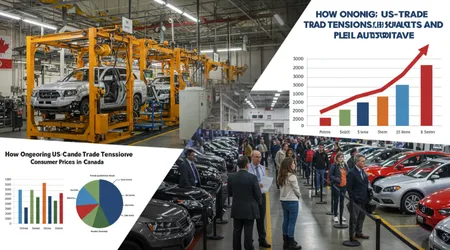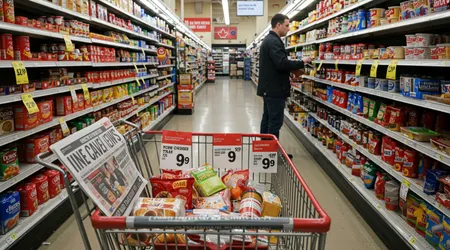How Ongoing US-Canada Trade Tensions Are Impacting Consumer Prices in Canada

The escalating trade tensions between the United States and Canada, rooted in recent tariff policies, are reshaping the economic landscape for Canadian consumers.
Since early 2025, U.S. tariffs, including a 25% levy on Canadian goods like steel, aluminum, and vehicles, have sparked retaliatory measures from Ottawa, targeting $155 billion in American imports.
These tit-for-tat policies disrupt supply chains, elevate production costs, and ultimately drive up consumer prices.
This article explores how trade tensions ripple through Canada’s economy, affecting everyday purchases, from groceries to cars, while offering practical insights for navigating this turbulent period.
With inflation already a concern Statistics Canada reported a Consumer Price Index (CPI) rise to 2.8% in February 2025 these tensions amplify financial pressures on households.
Why should Canadians care? Because these economic shifts hit wallets directly, demanding attention and strategic planning.
The interplay of trade tensions and consumer prices is complex, involving global supply chains, domestic policies, and market psychology.
This piece draws on real-time data, expert analyses, and tangible examples to unpack the issue.
From a Vancouver grocer facing higher import costs to an Ontario autoworker grappling with job uncertainty, the impacts are personal and pervasive.
We’ll examine the mechanisms driving price hikes, sector-specific effects, and strategies for consumers, all while grounding our discussion in verified data, like the Bank of Canada’s projections.
Expect a clear, engaging narrative that avoids jargon, prioritizes clarity, and empowers readers with actionable insights to weather this economic storm.
The Mechanics of Trade Tensions and Price Inflation
Tariffs act like economic dams, restricting trade flows and raising costs. U.S. tariffs on Canadian goods, effective February 2025, increase export prices, reducing competitiveness.
Canadian retaliatory tariffs, targeting U.S. agriculture and machinery, add pressure, inflating import costs. This cycle directly impacts consumer goods prices.
Supply chain disruptions amplify these effects. Automotive parts crossing the Canada-U.S. border multiple times face cumulative tariffs, hiking production costs.
A Toronto car buyer now pays more for a sedan, as manufacturers pass on costs. This illustrates how trade tensions cascade through interconnected markets.
Inflation expectations also shift. The Bank of Canada notes that permanent tariffs cause one-time price jumps, but persistent trade tensions risk sustained inflation.
++ Automotive Industry Relief: Canada’s Strategic Move to Exempt Tariffs on Imported Vehicles
Businesses, anticipating higher costs, preemptively raise prices, embedding inflation into consumer markets. This psychological factor compounds economic strain.
Consider a Vancouver grocer importing U.S. oranges. Tariffs increase wholesale prices, forcing a 15% retail hike. Shoppers, already stretched, switch to pricier local produce.
This micro-level shift, multiplied across industries, underscores how trade tensions reshape purchasing habits and strain budgets.

Sector-Specific Impacts: Where Prices Hit Hardest
The automotive sector feels acute pain from trade tensions. Canada’s vehicle exports face U.S. tariffs, raising costs for manufacturers like Ford.
New car prices rose 0.9% in February 2025, per the CPI. Buyers face sticker shock, delaying purchases.
Grocery prices also climb. U.S. agricultural exports, like dairy and poultry, now carry 25% Canadian tariffs, pushing up supermarket costs.
Egg prices, already up 58.8% year-over-year due to avian flu, worsen with trade barriers. Low-income households feel this pinch most.
Also read: Tips for Buying Your First Home in Canada
Energy costs are another concern. A 10% U.S. tariff on Canadian oil increases gasoline prices, with Northeast U.S. pumps seeing up to 40-cent hikes per gallon.
Canadian refineries, reliant on cross-border trade, pass costs to consumers, inflating fuel budgets.
Retail goods, from apparel to electronics, face similar pressures. Tariffs on U.S.-made furniture and appliances raise prices in Canadian stores.
A Calgary family buying a new sofa now pays 10-15% more, squeezing discretionary spending and altering consumption patterns.
| Sector | Price Increase (Feb 2025) | Primary Cause |
|---|---|---|
| Automotive | 0.9% | U.S. tariffs on vehicles |
| Groceries (Eggs) | 58.8% (year-over-year) | Tariffs + avian flu |
| Gasoline | 5-40 cents/gallon | U.S. tariffs on Canadian oil |
| Retail Goods | 10-15% | Tariffs on U.S. furniture, appliances |
Economic Ripple Effects: Beyond the Checkout Counter
Job markets waver as trade tensions disrupt trade-dependent industries. Canada lost 33,000 jobs in March 2025, partly due to tariff-related uncertainty.
Manufacturers, hesitant to invest, freeze hiring, impacting workers’ incomes. This reduces consumer spending, slowing economic growth.
Business confidence erodes. The Bank of Canada cut rates to 2.75% in April 2025, signaling concern over tariff-driven stagnation.
Read more: Renting vs. Buying: Which Is Better for Canadians in 2025?
Firms delay expansions, fearing prolonged trade disputes. This hesitation stifles innovation, further pressuring Canada’s GDP, projected to grow below 1% in 2025.
Exchange rates fluctuate, complicating price dynamics. U.S. tariffs weaken the Canadian dollar, raising import costs for non-U.S. goods.
A Montreal importer now pays more for European electronics, passing costs to consumers. This broadens the inflationary impact beyond bilateral trade.
Small businesses suffer acutely. A Halifax café, reliant on U.S.-sourced coffee beans, faces 25% tariff hikes, forcing menu price increases.
Customers, balking at $6 lattes, cut visits, threatening the café’s viability.
This microcosm reflects broader economic strain on Canada’s service sector.
Consumer Strategies: Navigating the Price Surge
Households can adapt by prioritizing local products. Canadian-made dairy, exempt from U.S. tariffs, offers cost stability.
Shoppers in Winnipeg switch to local cheese, saving 5-10% on grocery bills. This supports domestic producers while cushioning wallets.
Budgeting becomes critical. Tracking expenses helps identify tariff-driven price spikes, like imported apparel. A Regina family cuts clothing purchases, redirecting funds to essentials.
Apps like Mint aid in visualizing spending, empowering smarter financial choices amid trade tensions.
Seeking tariff-exempt markets offers relief. Canada’s trade agreements with the EU (CETA) provide access to cheaper European goods.
A Quebec retailer stocks French wine over U.S. brands, maintaining margins. Consumers benefit from competitive pricing in tariff-free categories.
Energy conservation mitigates fuel cost spikes. Carpooling or public transit reduces gasoline expenses, critical as prices rise.
An Ottawa commuter saves $50 monthly by busing, offsetting tariff-driven pump price hikes. Small adjustments yield significant savings.
Policy Responses: Can Canada Mitigate the Damage?
Government intervention aims to soften tariff impacts. Subsidies for low-income households, proposed in 2025, could ease grocery price burdens.
These targeted measures prevent hoarding and stabilize demand, but funding constraints limit their scope.
Trade diversification is a long-term fix. Canada’s talks with Mexico and the EU aim to reduce U.S. trade reliance.
Strengthened CETA agreements could lower import costs, but scaling up takes years, offering little immediate consumer relief.
Monetary policy plays a role. The Bank of Canada’s rate cuts signal efforts to boost spending despite trade tensions.
Lower borrowing costs encourage investment, but persistent tariffs may offset gains, leaving inflation risks intact.
Provincial measures add complexity. Ontario’s surcharge on U.S. electricity exports retaliates against tariffs but risks higher utility bills.
This tit-for-tat approach, while symbolic, may backfire, increasing costs for Canadian consumers already stretched thin.
The Broader Global Context: A Trade War Analogy
Imagine a neighborhood potluck where one family demands higher fees for their dishes, prompting others to retaliate with their own charges.
Soon, everyone pays more, and the meal’s joy fades. This mirrors global trade tensions, where U.S. tariffs trigger retaliatory levies worldwide, raising costs universally.
Canada, heavily reliant on U.S. trade $581 billion in goods in 2017 faces outsized impacts.
As China, Japan, and the EU respond to U.S. policies, global supply chains strain, amplifying price pressures for Canadians.
This interconnected web underscores why bilateral disputes ripple far beyond borders.
Looking Ahead: Preparing for Prolonged Trade Tensions

Canadians must brace for sustained economic turbulence. Tariffs, if permanent, could shave 4% off Canada’s GDP by year-end, per economic models.
Consumers should diversify spending, favoring tariff-free goods to mitigate price hikes. Long-term, trade tensions may force structural shifts, like retooling supply chains.
Education empowers resilience. Understanding tariff impacts through resources like Statistics Canada’s CPI portal helps consumers anticipate price trends.
A Saskatoon teacher uses these tools to budget for school supplies, avoiding U.S.-made products hit by tariffs. Knowledge drives informed choices.
Advocacy matters, too. Engaging with policymakers to push for trade diversification can reduce future vulnerabilities.
Canadians voicing concerns via platforms like town halls influence Ottawa’s strategy, fostering policies that prioritize consumer relief over political posturing.
Conclusion: Empowering Canadians Amid Economic Shifts
The trade tensions between the U.S. and Canada, fueled by tariffs since February 2025, are more than diplomatic spats they’re reshaping household budgets.
From soaring egg prices (up 58.8% year-over-year) to pricier cars and fuel, Canadians face tangible financial strain.
Yet, this challenge offers opportunities: prioritizing local goods, leveraging trade agreements like CETA, and advocating for smart policies can soften the blow.
The road ahead demands vigilance tracking CPI trends, adjusting budgets, and supporting domestic industries.
By understanding these dynamics, Canadians can navigate the economic storm with confidence, turning uncertainty into a chance for resilience.
What will you do to shield your wallet from these global shifts? The answer lies in informed, proactive choices.
Frequently Asked Questions
1. How do tariffs cause price increases in Canada?
Tariffs raise import costs, which businesses pass to consumers. For example, U.S. tariffs on Canadian steel increase car prices, while Canadian retaliatory tariffs hike U.S. grocery costs.
2. Which products are most affected by trade tensions?
Automotive, groceries (especially eggs and dairy), gasoline, and retail goods like furniture face the steepest price hikes due to U.S. and Canadian tariffs.
3. Can consumers avoid tariff-driven price spikes?
Yes, by buying local or EU-sourced goods, budgeting tightly, and conserving energy. For instance, choosing Canadian cheese or carpooling saves money.
4. Will trade tensions lead to a Canadian recession?
Prolonged tariffs could slow growth below 1% in 2025, risking recession. Job losses (33,000 in March 2025) signal economic strain.
5. How long will these trade tensions last?
Uncertain, but negotiations continue. Temporary exemptions, like April 2025 auto tariff suspensions, suggest possible de-escalation, though global trade dynamics complicate timelines.
